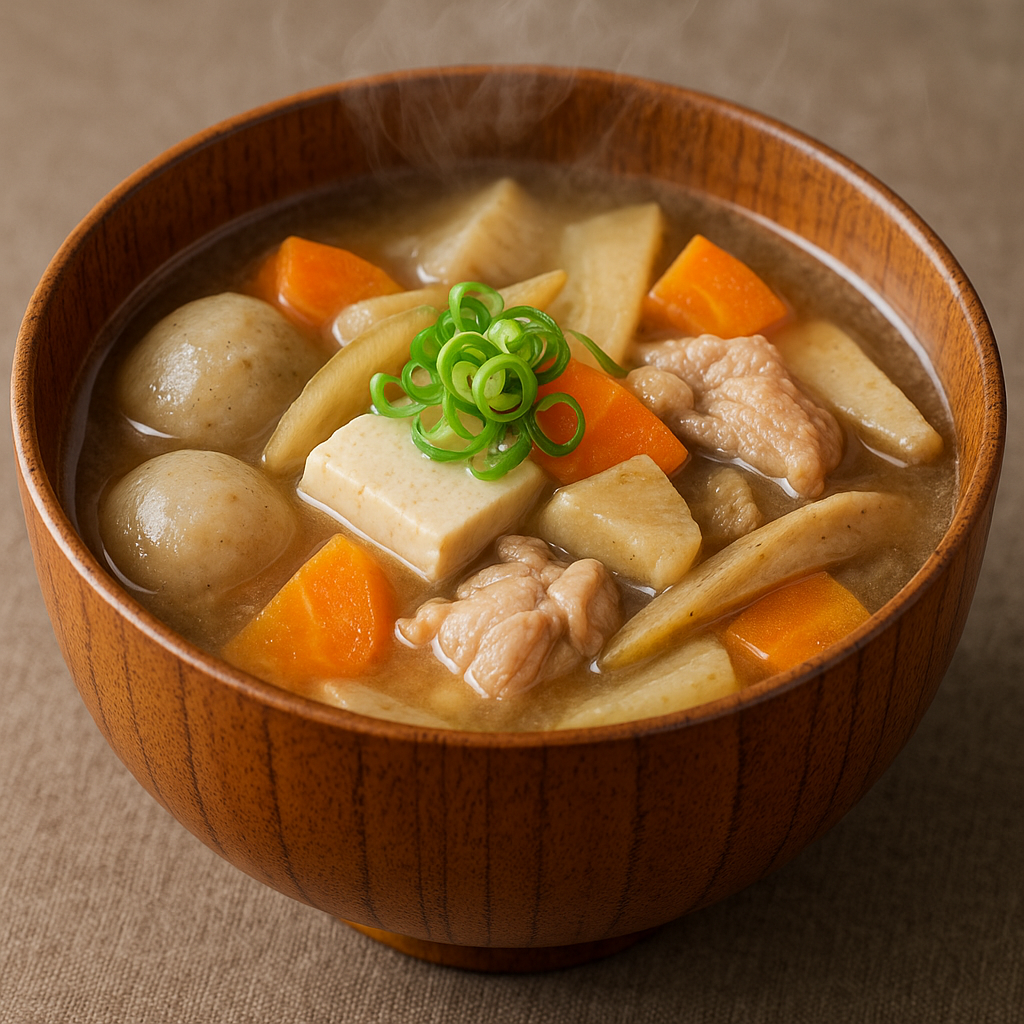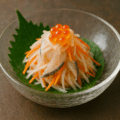いもの子汁(岩手)の特徴
里いもを主役に、根菜ときのこで旨みを重ねる汁物
いもの子汁は、里いもを主役にごぼう・にんじん・こんにゃく・きのこなどを合わせ、だしで煮含めて仕上げる郷土の汁物です。とろりとした里いもの口当たりと、根菜の香り、きのこの旨みが一椀にまとまります。
味噌派/しょうゆ派、具材の違いで個性が生まれます
岩手では味噌仕立て・しょうゆ仕立ての両方が見られ、豚肉・鶏肉・牛肉や鮭など具材の選び方で個性が出ます。土地のだし文化と組み合わせて、家庭ごとの味が受け継がれています。
いもの子汁(岩手) レシピ
材料(5人分)
- 里いも(皮むき) 500g
- ごぼう 100g
- にんじん 100g
- 豆腐 一丁
- 豚バラ薄切り 200g(鶏肉・牛肉・鮭で代用可)
- だし 1,000ml(昆布+かつお、または煮干し)
- 味噌 60〜80g(しょうゆ 大さじ1〜2で風味調整可)
- 酒 大さじ2/みりん 大さじ1(任意)
- ごま油 少量(炒め用)/塩 少々(調整用)
- (好みで)七味唐辛子 少々
作り方
- 1. 里いもは皮をむき、一口大に切る。塩少々で揉み、ぬめりを洗い流す。
- 2. ごぼうはささがきにして水にさらす。にんじんはいちょう切り。豆腐はさいの目切り。
- 3. 鍋にごま油を温め、肉を軽く炒める。ごぼう・にんじんを加え、油を回す。
- 4. だしを注いで煮立て、アクを引く。中火で約10分煮る。
- 5. 里いもを加え、やわらかくなるまで12〜15分煮る。
- 6. 弱火にして味噌を溶き入れる。しょうゆ・酒・みりんで風味を整える。
- 7. 味を見て塩で調える。器によそい、好みで七味をふる。
シェフのワンポイントアドバイス
- 里いもは塩もみ→洗いでぬめりを適度に落とすと、だしが澄みやすいです。
- 里いもは厚く剥いた方がアクが少なく、美味しいです。
- 味噌は火を止める直前に溶くと香りが残ります。しょうゆ少量で締めると味に奥行きが出ます。
- 肉を鮭に替える場合は、味噌の方が相性が良く、牛肉はしょうゆがおすすめです。
栄養価(1人分の目安)
- エネルギー:180〜280 kcal
- たんぱく質:10〜16 g(具材により変動)
- 脂質:6〜12 g
- 炭水化物:20〜35 g(里いも由来)
- 食物繊維:4〜7 g(根菜・きのこ由来)
歴史
収穫の鍋として広がった里いもの汁
秋の収穫期に里いもと身近な野菜・保存食を鍋に合わせたのが始まりとされ、行事や集まりの一椀として受け継がれてきました。
だしと調味の違いが“家庭の味”を形づくりました
昆布・かつお・煮干しなどのだし文化に、味噌・しょうゆの使い分けが重なり、同じ名前でも家庭ごとに味わいが異なる一品として親しまれています。
English Version
Features of Imonoko-jiru (Iwate)
A taro-centered soup layered with root veggies and mushrooms
Imonoko-jiru is a regional soup featuring taro with burdock, carrot, konnyaku, mushrooms, and more, gently simmered in dashi. The silky taro, aromatic roots, and savory mushrooms come together in one comforting bowl.
Miso or soy styles, with meats or salmon for character
In Iwate you’ll find both miso- and soy-based versions. Pork, chicken, beef, or salmon are used depending on the household, reflecting local dashi traditions and family taste.
Imonoko-jiru (Iwate) – Recipe
Ingredients (Serves 5)
- Taro (satoimo), peeled 500 g
- Burdock root 100 g
- Carrot 100 g
- Tofu 1 block (firm), diced
- Pork belly, thin-sliced 200 g (or chicken / beef / salmon)
- Dashi 1,000 ml (kombu + katsuobushi, or niboshi)
- Miso 60–80 g (soy sauce 1–2 Tbsp to adjust)
- Sake 2 Tbsp / mirin 1 Tbsp (optional)
- Sesame oil, a little (for sautéing) / salt, to taste
- Shichimi togarashi, optional
Directions
- 1. Peel taro and cut into bite-size pieces. Rub with a little salt and rinse to remove slime.
- 2. Shave burdock into sasagaki and soak in water. Slice carrot into half-moons. Dice tofu.
- 3. Warm sesame oil in a pot; lightly sauté the pork. Add burdock and carrot; toss with oil.
- 4. Add dashi and bring to a simmer; skim scum. Cook about 10 minutes over medium heat.
- 5. Add taro and simmer 12–15 minutes until tender.
- 6. Lower heat; dissolve in miso. Adjust flavor with soy sauce, sake, and mirin.
- 7. Check seasoning with salt. Ladle into bowls and sprinkle shichimi if desired.
Chef’s Tips
- Salt-rub → rinse on taro helps clarify the broth.
- Peel taro slightly thicker to reduce harshness and improve texture.
- Add miso just before turning off the heat to preserve aroma; a splash of soy adds depth.
- With salmon, a miso-forward base pairs well; with beef, lean a bit more soy.
Nutrition (per serving, approx.)
- Energy: 180–280 kcal
- Protein: 10–16 g (varies with proteins used)
- Fat: 6–12 g
- Carbohydrates: 20–35 g (mainly from taro)
- Dietary fiber: 4–7 g (roots & mushrooms)
History
A harvest-time pot turned family staple
Believed to have begun as an autumn harvest soup combining taro with familiar vegetables and preserved foods, it became a dish for gatherings and local events.
Dashi and seasoning shape each “home taste”
Regional stocks—kombu, katsuobushi, niboshi—and the choice of miso or soy created distinct household styles, making imonoko-jiru a beloved, varied classic.



何でも質問してください!